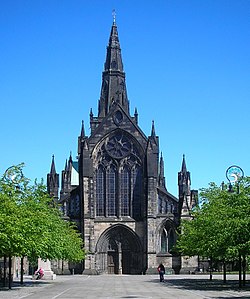Difference between revisions of "Glasgow Cathedral"
(→Outside links) |
m (→References) |
||
| Line 55: | Line 55: | ||
==References== | ==References== | ||
{{reflist}} | {{reflist}} | ||
| − | |||
| − | |||
Latest revision as of 12:19, 10 November 2019
| The High Kirk of Glasgow | |
|
Glasgow, Lanarkshire | |
|---|---|
| Status: | Parish church |
 Glasgow Cathedral, from Cathedral Square | |
| Church of Scotland | |
| Presbytery of Glasgow | |
| Location | |
| Grid reference: | NS60186556 |
| Location: | 55°51’47"N, 4°14’4"W |
| History | |
| Information | |
The High Kirk of Glasgow, usually known as Glasgow Cathedral is the major and foremost church of the Church of Scotland in Glasgow.
The church is known most frequently as Glasgow Cathedral, or St Kentigern's or St Mungo's Cathedral. The title 'cathedral' is honorific and historic, dating from the period before the Reformation and the final abolition of the office of bishop in the Kirk by the Prelacy Act of 1690: before 1690 the church had been the seat ('cathedra') of an archbishop and the mother church of the Archdiocese of Glasgow.
The current congregation is part of the Church of Scotland's Presbytery of Glasgow. Glasgow Cathedral is located north of High Street and east of Cathedral Street, beside the Glasgow Royal Infirmary.
Contents
History
The history of the cathedral is linked with that of the city, and is allegedly located where the patron saint of Glasgow, Saint Mungo, built his church. The tomb of the saint is in the lower crypt. Walter Scott's novel Rob Roy gives an account of the kirk.
The cathedral was built long before the Reformation, from the late 12th century onwards, and it served as the seat of the Bishop and later the Archbishop of Glasgow. It is a superb example of Gothic architecture. It is also one of the few Scottish mediæval churches (and the only mediæval cathedral on the Scottish mainland) to have survived the Reformation without being unroofed.
King James IV ratified the Treaty of Perpetual Peace with England at the high altar on 10 December 1502,[1] 11 years before he invaded England and was slain at Flodden Field. The cathedral and the nearby castle played a part in the Battles of Glasgow in 1544 and 1560.[2]
Twenty years after the Reformation, on 22 April 1581, King James VI granted the income from a number of lands to Glasgow town for the kirk's upkeep. He traced the ownership of these lands to money left by Archbishop Gavin Dunbar as a legacy for repairing the cathedral.[3] The town council agreed on 27 February 1583 to take responsibility for repairing the kirk, while recording they had no obligation to do so.[4] The church survives because of this resolution. Inside, the rood screen is also a very rare survivor in the Church of Scotland.
Technically, the building is no longer a cathedral, since it has not been the seat of a bishop since 1690. However, like many other pre-Reformation cathedrals in Scotland, it is still a place of active Christian worship, hosting a Church of Scotland congregation.
The building itself is in the ownership of the Crown, is maintained by Historic Scotland, and is a popular destination for tourists.
University of Glasgow
- Main article: University of Glasgow
The University of Glasgow originated in classes held within the precinct of the Cathedral. William Turnbull, Bishop of Glasgow was primarily responsible for the foundation of the University around the year 1451. The Bishops of Glasgow served as Chancellors of the University for around two hundred years. In 1460, the University moved out of the Cathedral to an adjacent site on the east side of the High Street, and moved to its current home on Gilmorehill in 1870.
Music
Glasgow Cathedral's professional choir is composed of 8 Choristers and 6 Choral Scholars. The four-manual Father Willis organ was installed in 1879, and has been maintained by Harrison & Harrison since they rebuilt the instrument in 1996.
Other cathedrals in Glasgow
Other denominations maintain cathedrals of their own in Glasgow: St Mary's Cathedral of the Scottish Episcopal Church, St Luke's Cathedral of the Eastern Orthodox Church and St Andrew's Cathedral of the Roman Catholic Church,
Outside links
| ("Wikimedia Commons" has material about Glasgow Cathedral) |
- Glasgow Cathedral
- Glasgow Cathedral - Historic Environment Scotland
- Glasgow Cathedral Precinct – History and original drawings of the Cathedral area.
- Glasgow Cathedral – from Virtual Scotland
- Glasgow Cathedral Photographs
| "Cathedrals" of the Church of Scotland |
|---|
|
St Machar, Aberdeen • Holy Trinity, Brechin • St Mary, Dornoch • St Blane, Dunblane • St Columba, Dunkeld • St Giles, Edinburgh • St Mungo, Glasgow • St Magnus, Kirkwall • St Moluag, Lismore |
References
- ↑ Bain, Joseph, ed., Calendar of Documents relating to Scotland, 1357–1509, vol. 4, HM Register House, Edinburgh (1888), p.339, nos.1690–2
- ↑ Dickinson, Gladys, ed., Two Missions of de la Brosse, SHS (1942), 81, 85–87
- ↑ Register of the Privy Council of Scotland, vol. 8, HMSO (1982), 38–39, no. 232.
- ↑ Extracts from the Burgh Records of Glasgow, (1876), 100.


